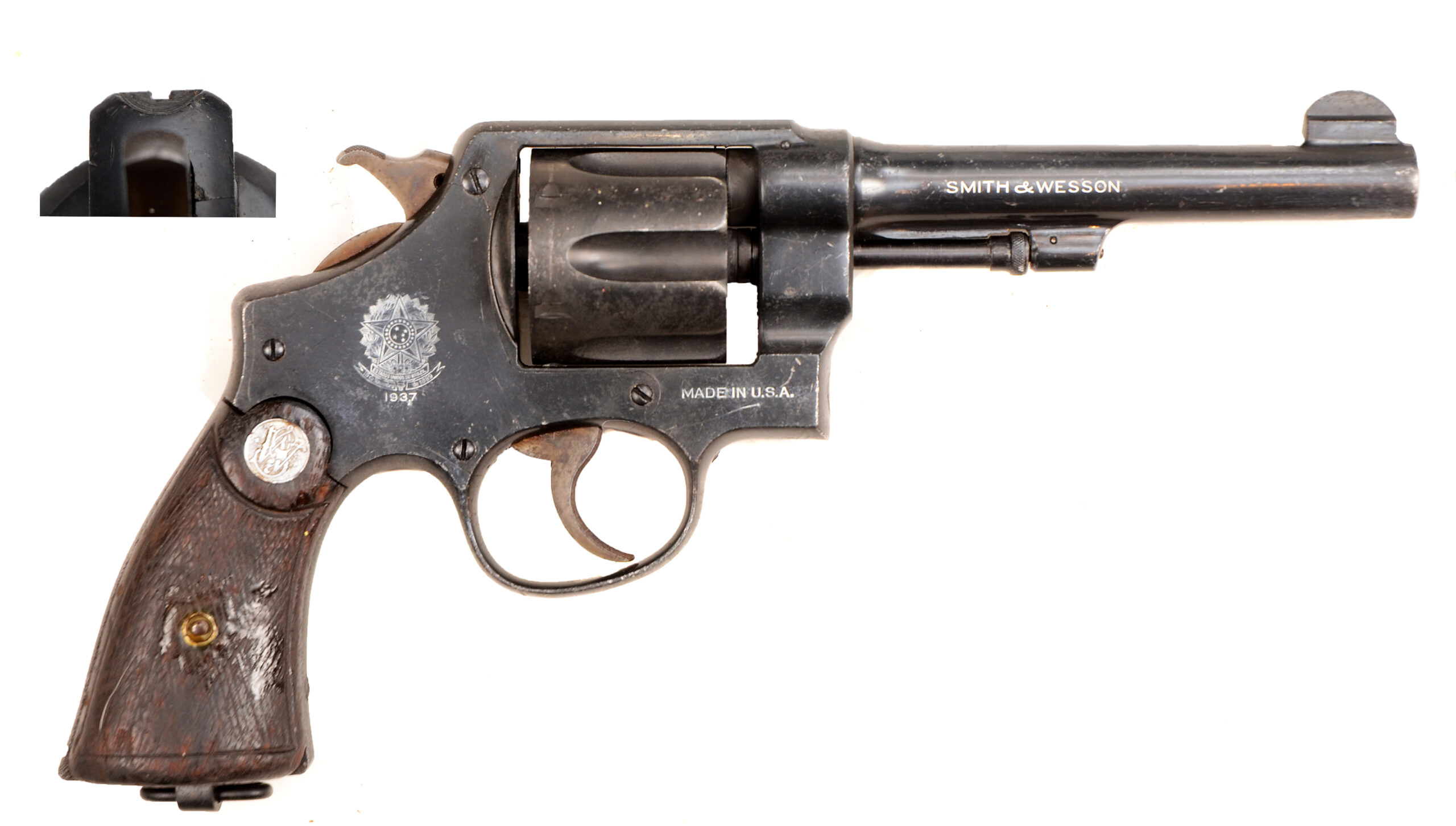The Colt and Smith & Wesson Model of 1917 double-action, six-shot revolvers had been manufactured during World War I to supplement a shortage of the semiautomatic 1911 pistols. After the War ended in November 1918, many of the weapons from the War were returned to the United States, to be inspected and rebuilt or repaired as needed. After being refurbished, most were placed into storage. However, many of the revolvers remained in service with the military police during the post-War years.
The Smith & Wesson Model of 1917 design was different than those manufactured by Colt. No parts were interchangeable; although both revolvers used the same three-cartridge, half-moon clips.
Smith & Wesson (S&W) manufactured an estimated 163,635 U.S. Model of 1917 .45 caliber revolvers from 1917 to the early months of 1919. The contracts were terminated at the end of World War I. After the War, there remained a rather large number of new frames and parts. The government wanted S&W to purchase all the left-over inventory, which the company initially refused, but later agreed to in a deal.
After World War I, Smith & Wesson continued manufacturing the Hand Ejector Model 1917 revolver, with checkered grips and bright bluing, for the civilian market until 1948. Most of the post-War commercial revolvers were assembled with new, not surplus parts. Later S&W introduced a new .45 ACP caliber 25-2 modernized revolver followed by the stainless-steel Model 625.
In addition to the U.S. military and commercial sales of the M1917 revolvers, a number were sold to Brazil. During 1936, Brazil began to modernize the weapons being fielded by their Armed Forces. Previously, the standard military sidearm had been the 7.65mm Luger pistol, originally purchased in 1908, a few original S&W .38 caliber revolvers and the 92 Espagnol, a Spanish copy of the S&W Model 10. One of the goals of the modernization program was to adopt a standard caliber; the .45 ACP cartridge was chosen.
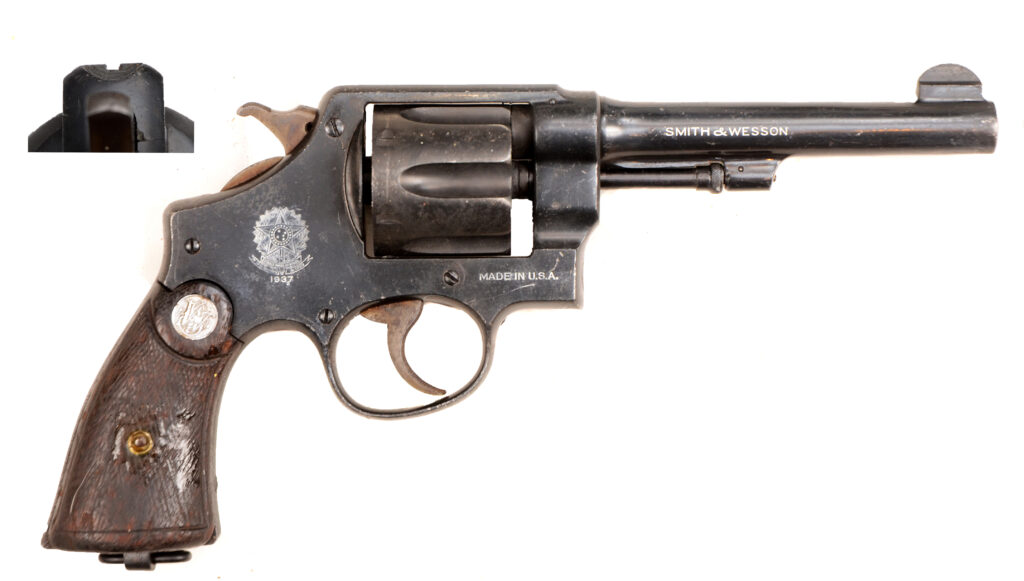
Two Brazilian Contracts
There were two separate contracts for the Model 1917/1937 revolvers. The first Brazilian contract was for 25,000 weapons, shipped during 1938. Assigned serial numbers were from 181983 to 207043. Generally, most of the revolvers in the first contract were much like the post-War production, commercial Model 1917. Features of those guns were flat-top frames with a square-shaped, rear sight notch, checkered grips with the S&W silver medallion, commercial blue finish and the S&W trademark on the left side of the frame.
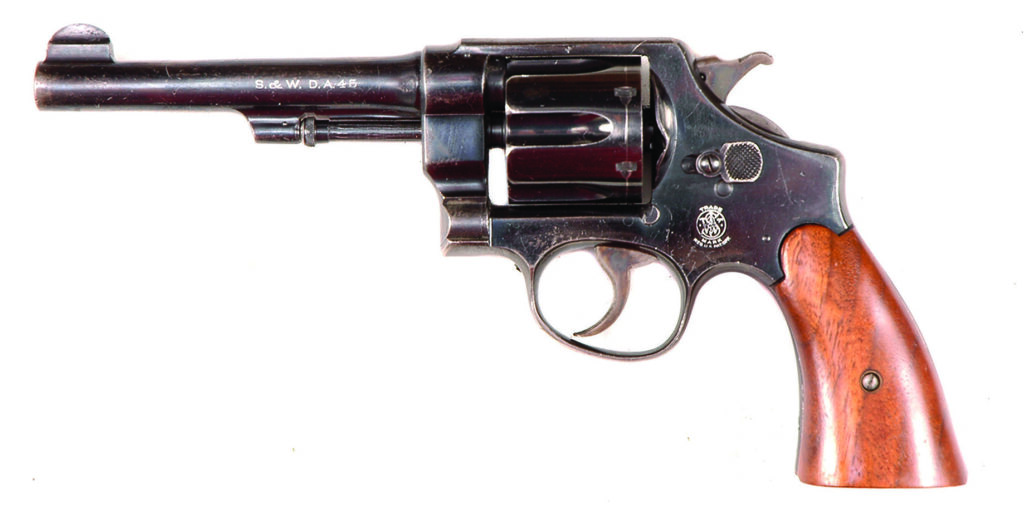
A second Brazilian contract group of 12,000 revolvers was amassed in 1946, with two serial number ranges: from 166000 to 175150 and 207196 to 209878. Note that some of the serial numbers are lower than the revolvers made in the first Brazilian contract; this is because most of them were assembled from surplus U.S. military parts made during World War I.
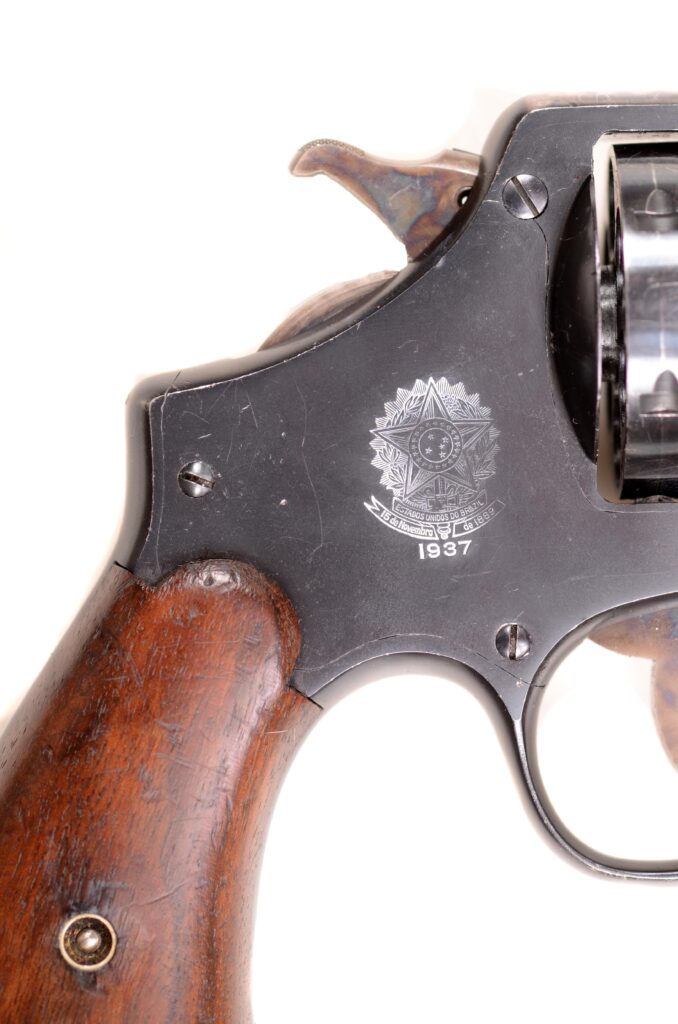
NOTE: There have been Brazilian contract revolvers reported that do not fall into any of the documented serial number ranges.
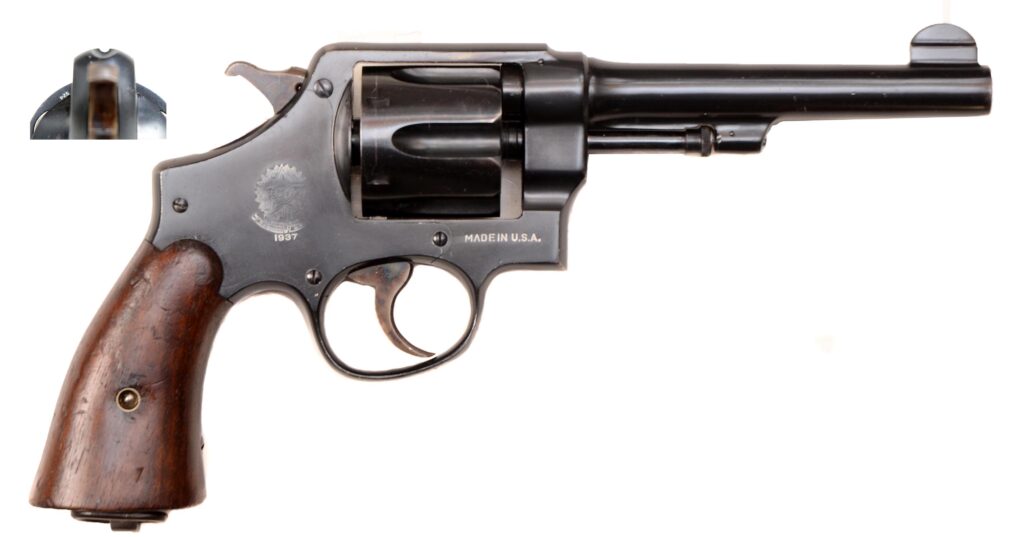
With the second Brazilian contract, Smith & Wesson was able to use many of the spare parts left over from their U.S. World War I contracts. Many of the revolvers in the second contract had World War I-style, round-top frames with a U-shape rear sight notch, smooth military-style grips, a blue satin finish and military inspection stamps on many of the parts.
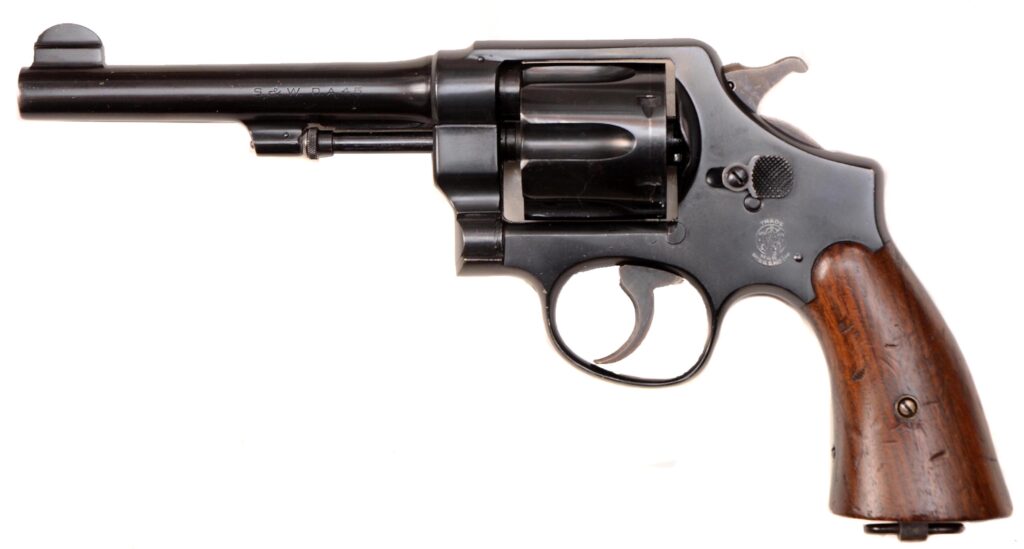
Variances Between Modelo 1937s and M1917s
The Brazilian nomenclature for the revolvers was the “Modelo 1937.” The Brazilian contract revolvers differed slightly from the U.S. military Model 1917 guns. One of the most obvious differences was the addition of the Brazilian Crest and 1937 date on the right side of the frame, along with “MADE IN THE U.S.A.” On the left side, the Smith & Wesson trademark was added. The Made in the USA and S&W trademark were not marked on U.S. military M1917 revolvers. The triggers on U.S. military M1917s were smooth; the triggers on the Brazilian guns were serrated. Two styles of wooden grips were used on Brazilian guns: U.S. surplus smooth grips and checkered grips with the S&W medallion. The left side of the barrel was roll marked: “S&W D.A. .45,” and the top of the barrel was marked: “SMITH & WESSON SPRINGFIELD MASS U.S.A. PATENTED DEC. 17, 1901 FEB. 6, 1906, SEP. 14 1909.” Some of the first Brazilian contract revolvers with post-War commercial barrels were marked: “SMITH & WESSON” on the right side.
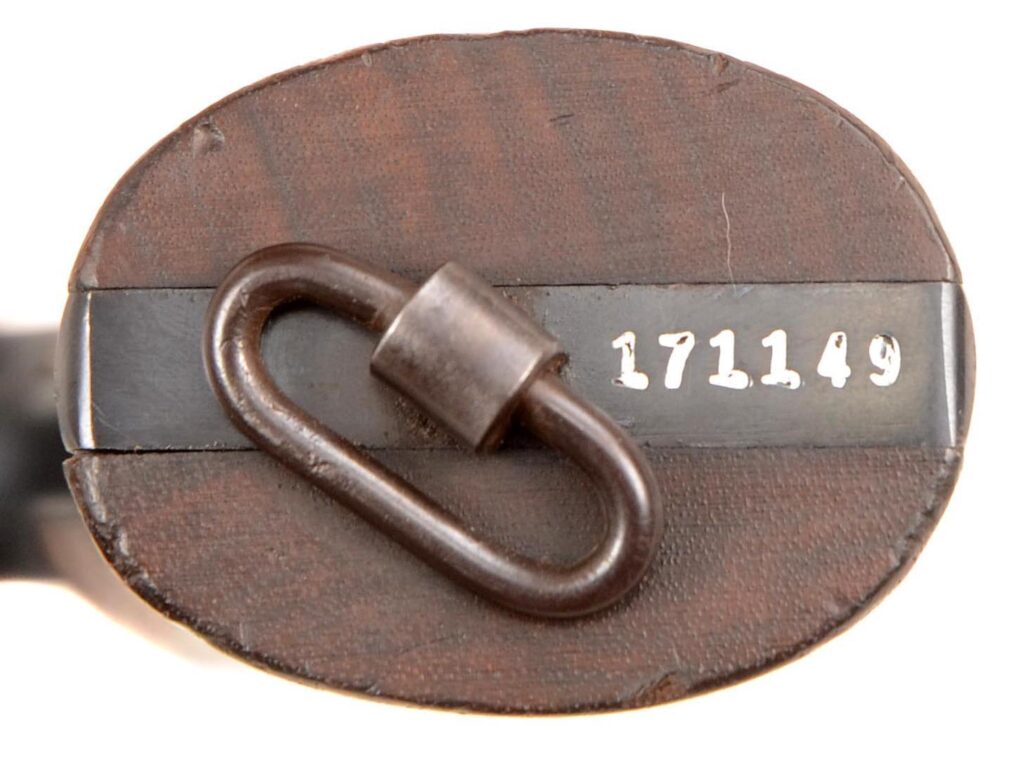
The Brazilian seal on the right side of the revolvers is marked: “ESTADOS UNIDOS DO BRAZIL 15 Novembro de 1899.” (Translated from Portuguese: UNITED STATES OF BRAZIL 15 November 1899.) The date, 15 November 1889, is that of a military coup d’état that established the First Brazilian Republic after the overthrow of the constitutional monarchy of the Empire of Brazil, ending the reign of Emperor Pedro II. On that same day, 15 November, a provisional government was established with Marshal Deodoro da Fonseca as president of the Republic and head of the interim government. The 1937 date is when the revolvers were adopted.
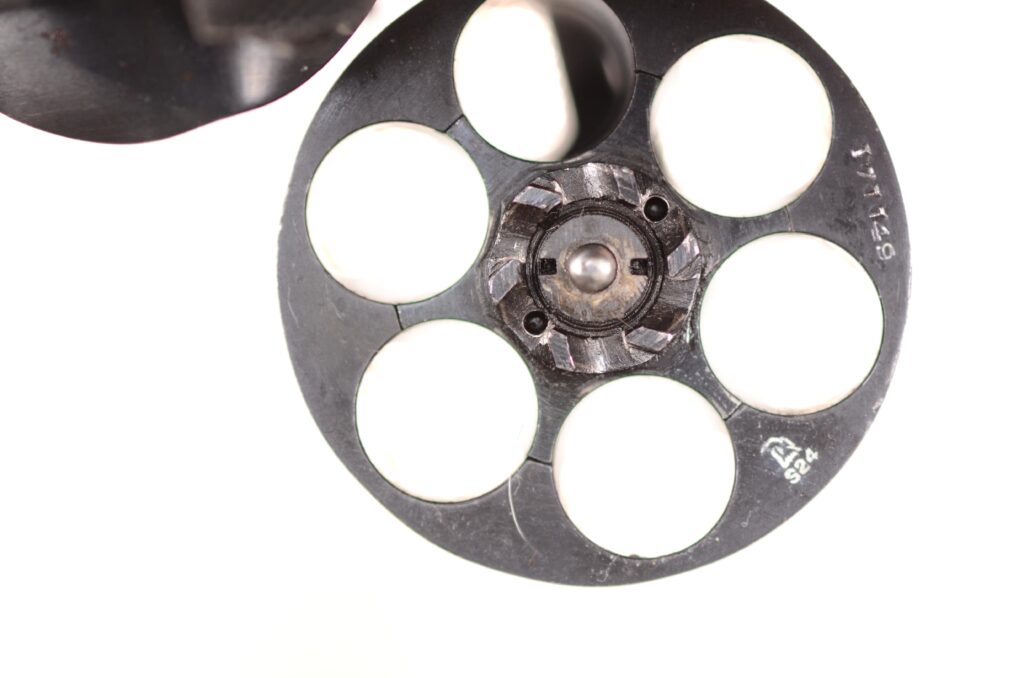
The Brazilian firm of IMBEL (Indústria de Material Bélico do Brasil, or Brazilian War Material Industry) located in Itajubá, Minas Gerais, Brazil, made replacement barrels and possibly other repair parts for the Modelo 1937 revolvers. The IMBEL-made barrels were marked: “FABRICA DE ITAJUBA Rv .45 M1917” on the right side. Spare barrels were also manufactured by another Brazilian plant stamped with the letters “I.N.A.” representing “Industria Nacional de Armas, National Arms Factory,” located in Santo André, a city in the State of São Paulo.
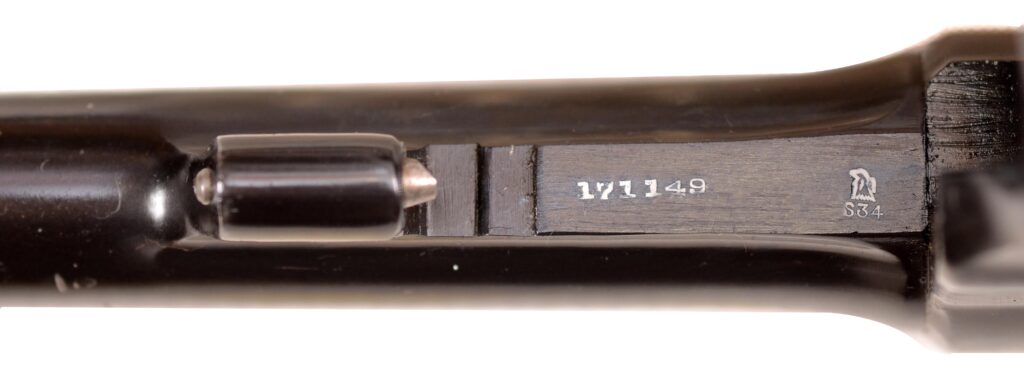
Nature of Importing
After manufacture and quality inspection at the Smith & Wesson factory, the Brazilian contract revolvers were delivered to John Block, New York City, NY, the purchasing agent for the Brazilian government. The revolvers were shipped in blue cardboard boxes that had a yellow label on the end with the words, “U.S. ARMY 45 MODEL BLUED 5 ½ INCH. SMITH & WESSON, SPRINGFIELD, MASS.” Inside the lid were instructions printed in English and Portuguese. On the bottom of the box, stamped in ink was: “MADE IN THE UNITED STATES OF AMERICA.” The serial number of the revolver was handwritten on the box. Packed with the revolver were a cleaning rod and bronze bore brush. The S&W revolvers remained in service with Brazil’s military for over 30 years and were finally withdrawn from use in the 1970s.
During 1989 to 1990, a large number of the Brazilian contract Modelo 1937 S&W revolvers were sold to importers in the United States for the civilian market. The condition of the surplus revolvers varied from poor to good, with a very small number in very good to excellent condition. Most of the revolvers were mechanically sound, but most had worn, scratched, freckled or patinated finishes. Like the 1917 models, the Brazilian M1937 revolvers are Curio and Relic (C&R) eligible.
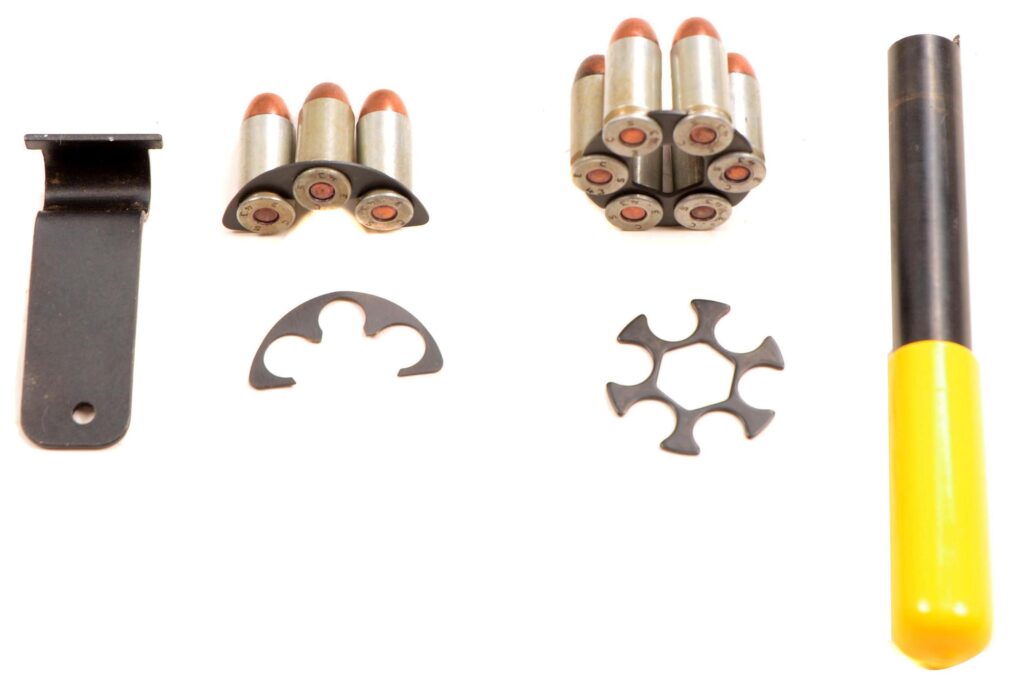
The Gun Control Act (GCA) of 1968 required all firearms imported into the U.S. that were not considered antiques to have the name and address of the U.S. company that imported them, along with the model, caliber and country of origin. The information had to be conspicuously engraved, cast, stamped or laser-written in text at least .003-inch deep. The serial number had to be in Roman letters and Arabic numerals, the serial number could not contain any Cyrillic- or Greek-style characters. The serial number had a minimum height requirement of no less than 1/16 of an inch. However, if any of that information already appeared on the firearm from the original manufacturer, it did not need to be duplicated; which is why the S&W revolvers imported back into the U.S. only required minimum import stamps.
Examples of the Brazilian contract M1937 revolvers can regularly be found on any of the online gun auction sites. Unfortunately for Brazilian firearm collectors, very few of the S&W Modelo 1937 revolvers remain in their country.
Note: The spelling of Brazil was the correct spelling of that South American country until 1943, when an orthographic revision was made, changing the spelling to “Brasil.”
Importer Markings
U.S. Importer’s markings noted on Brazilian Modelo 1937 revolvers imported during 1989-1990 include:
NA RGDFLD. N.J. Navy Arms Company Ridgefield, NJ
Some were import-marked under the grips; others on the bottom of the barrel.
CAI ST AVT Century Arms International St Albans, VT
Generally marked on the bottom of the barrel.
IA CO SAC CA InterAmerican Import/Export Sacramento, CA
Marked on the barrel, hidden under the ejector rod.
| This article first appeared in Small Arms Review V24N9 (November 2020) |



